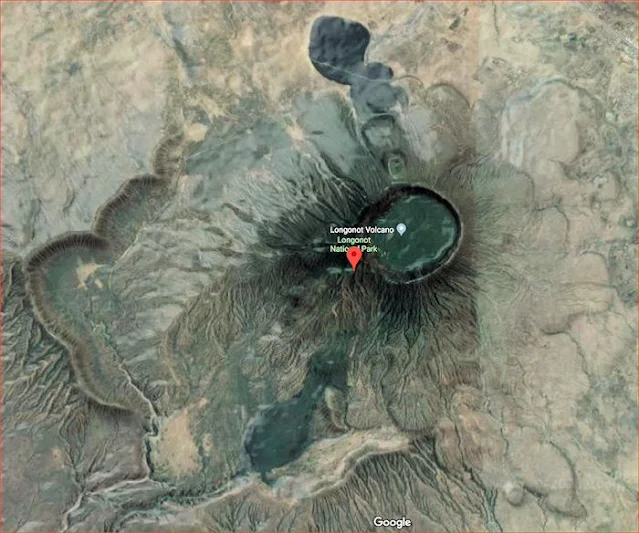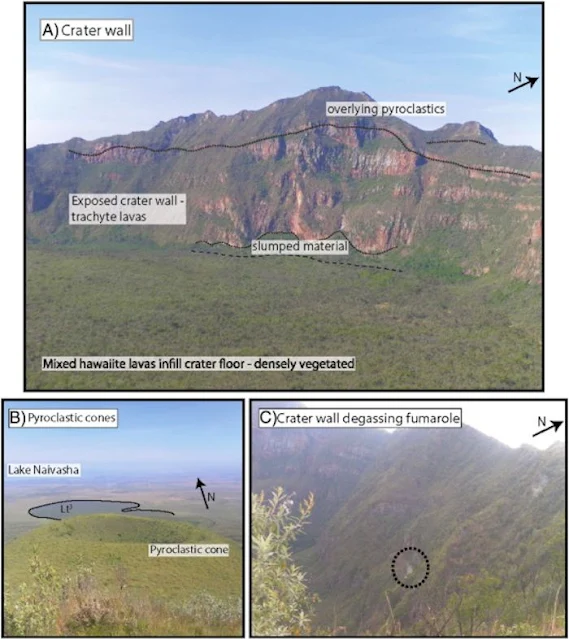Longonot is situated 30 kilometres north of Suswa and 20 kilometres southeast of the Olkaria rhyolite dome field.
Eruptive materials in the area differ somewhat, with phonolites in Suswa, trachytes in Longonot, and rhyolite in the Olkaria domes.
There are multiple parasitic cones on the volcano itself.
Lonogonot experiences both effusive and explosive geological eruptions, with effusive mountain-building followed by explosive caldera creation with significant pyroclastic production.
After the eruptions that make calderas, there is usually a short period of effusive activity, and then the cycle starts all over again.
The Longonot magma system has changed over the past 15,000 years in a way that is similar to how other trachyte centres (like the Laacher See and the Azores) have changed.
The magmas began as basalts and quickly underwent fractional crystallization to change into trachytes and hawaiites, with storage durations of only a few thousand years.
This might also point to a magma chamber with multiple levels.
From Longonot, seven instances of activity are known.
This began with the development of a massive 280 km3 primitive trachyte composite cone. Most of the original lava pile and the recently developed caldera are covered in pyroclastic material.
Although it is believed that the original structure was in use in the same period as Suswa, its exact age is unknown.
Significant flood lavas were being released as a result of rift floor faulting. It is believed that activity at Suswa and Longonot began around 400,000 years ago.
There were significant pyroclastic eruptions 21,000–6,000 years ago. A caldera-forming eruption occurred between periods of pyroclastic activity.
According to some authors, the first caldera event occurred 21,000 years ago. These eruptions produced at least 50 km3 of eruptive output overall.
According to VOGRIPA, this eruption had a VEI of 6.7 and occurred around 11,000 years ago. The freshly formed caldera's estimated volume is close to 27 km3.
Pyroclast flows, base surges and airfall deposits were created during eruptions that followed the caldera collapse.
These partially encircle the volcano's crater, mantle its walls, and partially fill it. Magma and groundwater are thought to have mixed after the caldera collapsed, causing a lot of base surge deposits and breccias.
Three categories can be used to describe the post-caldera activity: Following the caldera collapse, there was an early group of mixed trachyte and hawaiite lavas (0.5 km3) on the northern Longonot plains, followed by trachyte lavas on the main lava pile, and then a succession of ashy eruptions before the second caldera collapse.
The eastern caldera floor was partially filled by the trachyte lavas on the main pile. They also came from flank vents, similar to how the most recent activity has come from these vents.
These lava flows have a minimum total volume of 16 km3. In some spots, pyroclastic flows and airfall have entirely buried these lavas.
Before the second caldera collapse, which happened around 3,500 years ago, explosive activity picked up again, covering the summit of the pile with thick ash layers.
Over 2 km3 was deposited during these eruptions. The summit was covered in ash and the lava pile collapsed asymmetrically to create the second crater/caldera.
Once more, effusive eruptions of more than 0.34 km3 of trachytes onto the crater or caldera floor occurred after the collapse of the crater or caldera.
Small trachyte lava flows that erupted in effusive flank eruptions are the most recent activity. At least four flow units were released by the first of these from what appeared to be a radial fissure that was focused on the pit crater collapse.
Another lava flow with several units is present on the main pile's northern slopes, and it is once more concentrated on a radial fissure. With subsequent flow units, both of these flows transform from pahoehoe to 'aa' lavas. The lava volume is around 0.05 km3.




إرسال تعليق
What is your say on this